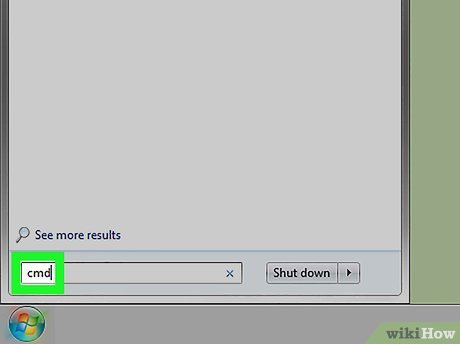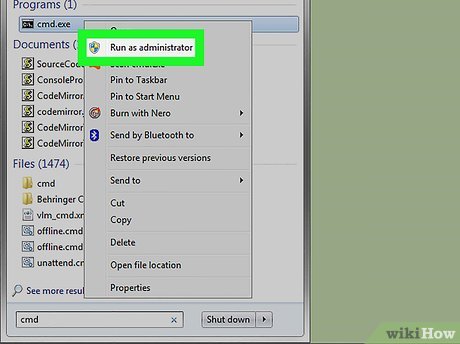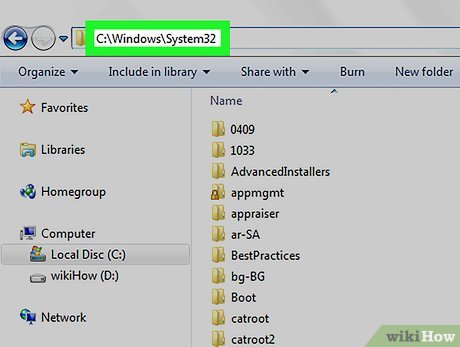How to Change Directories in Command Prompt
Part 1 of 2:
Opening Command Prompt
-
 Open Start. Either click the Windows logo in the bottom-left corner of the screen, or press the ⊞ Win key.
Open Start. Either click the Windows logo in the bottom-left corner of the screen, or press the ⊞ Win key.- For Windows 8, place your mouse cursor in the top-right corner of the screen, then click the magnifying glass icon when it appears.
-
 Type in cmd. This will bring up the Command Prompt icon at the top of the Start window.
Type in cmd. This will bring up the Command Prompt icon at the top of the Start window. -
 Right-click Command Prompt. It resembles a black box. This invokes a drop-down menu.
Right-click Command Prompt. It resembles a black box. This invokes a drop-down menu. -
 Click Run as administrator. It's near the top of the drop-down menu. Doing so will open Command Prompt with administrator privileges.
Click Run as administrator. It's near the top of the drop-down menu. Doing so will open Command Prompt with administrator privileges.- Confirm this choice by clicking Yes when prompted.
- You won't be able to run Command Prompt in administrator mode if you're on a restricted, public, or networked computer (e.g., a library or school computer), or an otherwise non-administrator account.
Part 2 of 2:
Changing the Directory
-
 Type in cd . Make sure you include the space after "cd". This command, which stands for "change directory", is the root of any directory change.
Type in cd . Make sure you include the space after "cd". This command, which stands for "change directory", is the root of any directory change.- Don't press the ↵ Enter key.
-
 Determine your directory's path. A directory path is like a map to a specific folder. For example, if the directory to which you want to change is the "System32" folder that's in the "WINDOWS" folder on the hard drive, the path would be "C:WINDOWSSystem32".
Determine your directory's path. A directory path is like a map to a specific folder. For example, if the directory to which you want to change is the "System32" folder that's in the "WINDOWS" folder on the hard drive, the path would be "C:WINDOWSSystem32".- You can find a folder's path by opening My Computer, double-clicking the hard drive icon, navigating to your destination, and then looking at the address at the top of the folder.
-
 Type in your directory's path. Your command or address goes after the "cd" command; make sure there is a space between "cd" and your command.
Type in your directory's path. Your command or address goes after the "cd" command; make sure there is a space between "cd" and your command.- For example, your whole command might look like cd WindowsSystem32 or cd D:.
- Since your computer's default directory location will be the hard drive (e.g., "C:"), you don't need to type in the hard drive's name.
-
 Press ↵ Enter. Doing so will change the Command Prompt directory to your selected one.
Press ↵ Enter. Doing so will change the Command Prompt directory to your selected one.
5 ★ | 1 Vote
You should read it
- How to Open Folders in CMD
- How to use the command history function in Command Prompt
- Use CMD to create an 'undeleted' folder on Windows
- 6 ways to rename files and folders in Windows 10
- How to Execute a Program in Command Prompt
- How to Change Default Folder in Windows Terminal
- How to change the folder in Command Prompt on Windows 10
- Add Command Prompt to Power User Menu on Windows 10
May be interested
- How to Make Command Prompt Appear at School
 this wikihow teaches you how to access command prompt on a windows 10 school computer. although you may be able to open command prompt if only the file path to command prompt is blocked, there is no way to bypass an administrator lock on...
this wikihow teaches you how to access command prompt on a windows 10 school computer. although you may be able to open command prompt if only the file path to command prompt is blocked, there is no way to bypass an administrator lock on... - Instructions to change IP address from Command Prompt
 to change the ip address on the computer is not difficult, you can use control panel. however, you may not know that using command prompt can also change the ip address. especially using the command prompt to change the ip address is much faster than using control panel.
to change the ip address on the computer is not difficult, you can use control panel. however, you may not know that using command prompt can also change the ip address. especially using the command prompt to change the ip address is much faster than using control panel. - 6 Best Command Prompt Alternatives for Windows
 do you find the command prompt a bit complicated and feel you need a tool that is easier to use? this is where other terminal emulators come into play!
do you find the command prompt a bit complicated and feel you need a tool that is easier to use? this is where other terminal emulators come into play! - How to use Xcopy command in Command Prompt
 knowing how to use xcopy command in command prompt, you will easily use commands in cmd professionally. in particular, the xcopy command is extremely useful for those who copy and copy data on the computer.
knowing how to use xcopy command in command prompt, you will easily use commands in cmd professionally. in particular, the xcopy command is extremely useful for those who copy and copy data on the computer. - 6 Cool Tricks You Can Do in Windows Command Prompt
 command prompt has a ton of capabilities, and many people doubt they know what a few lines of code can do. next time you're bored with your pc, try these cool command prompt tricks for yourself.
command prompt has a ton of capabilities, and many people doubt they know what a few lines of code can do. next time you're bored with your pc, try these cool command prompt tricks for yourself. - How to Change Your Computer's Date and Time Using Command Prompt
 today's tipsmake will show you how to change the date and time on a computer running windows operating system through the command prompt application. if you don't have administrator access, you won't be able to change the date and time.
today's tipsmake will show you how to change the date and time on a computer running windows operating system through the command prompt application. if you don't have administrator access, you won't be able to change the date and time. - Instructions for using Command Prompt
 deep in windows is a command-line world that is obscure. in this article, we will show you how to solve errors and make your computer more secure.
deep in windows is a command-line world that is obscure. in this article, we will show you how to solve errors and make your computer more secure. - All Frequency Restart, Shutdown, Remote Off ... with Command Prompt
 often users often turn off the computer, restart the computer ... using the shutdown options on the start menu. however, few of us know that using command prompt can also shutdown, restart the computer, schedule a computer shutdown or enable hibernation, ... and even if you have admin rights you can turn off other computers remotely.
often users often turn off the computer, restart the computer ... using the shutdown options on the start menu. however, few of us know that using command prompt can also shutdown, restart the computer, schedule a computer shutdown or enable hibernation, ... and even if you have admin rights you can turn off other computers remotely. - Open folder in Command Prompt (CMD)
 do you need to access a certain folder from the command prompt or windows command prompt? although it looks classic, this program is really easy to use if you know some basic commands. today's tipsmake will show you how to use the 'cd' command to open a folder in windows command prompt. besides, you will also learn great tips to immediately open the command prompt in any folder on windows file explorer.
do you need to access a certain folder from the command prompt or windows command prompt? although it looks classic, this program is really easy to use if you know some basic commands. today's tipsmake will show you how to use the 'cd' command to open a folder in windows command prompt. besides, you will also learn great tips to immediately open the command prompt in any folder on windows file explorer. - Windows prompt
 the prompt command changes the command prompt cmd.exe file.
the prompt command changes the command prompt cmd.exe file.












 How to Use Windows Command Prompt to Run a Python File
How to Use Windows Command Prompt to Run a Python File How to Kill a Process in Command Prompt
How to Kill a Process in Command Prompt How to Remotely Restart a Windows Machine Through Command Line
How to Remotely Restart a Windows Machine Through Command Line How to Use Net Send
How to Use Net Send How to Create and Delete Files and Directories from Windows Command Prompt
How to Create and Delete Files and Directories from Windows Command Prompt How to Decipher the Right Application to View an Unknown File Type on Windows Vista
How to Decipher the Right Application to View an Unknown File Type on Windows Vista